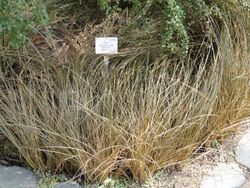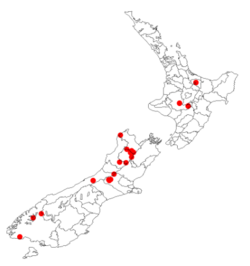Biology:Carex capillacea
| Carex capillacea | |
|---|---|

| |
| Carex capillacea | |

| |
| Isolectotype: AM AK2477-1 | |
| Scientific classification | |
| Kingdom: | Plantae |
| Clade: | Tracheophytes |
| Clade: | Angiosperms |
| Clade: | Monocots |
| Clade: | Commelinids |
| Order: | Poales |
| Family: | Cyperaceae |
| Genus: | Carex |
| Species: | C. capillacea
|
| Binomial name | |
| Carex capillacea | |

| |
| Occurrence data from AVH | |
Carex capillacea, common name yellowleaf sedge in Tasmania,[4] is a species of sedge (in the Cyperaceae family) found in Assam, the far east of Russia, New Guinea, south east Australia, New Zealand,[2] Malesia, China, Japan and India.[5]
Description
Carex capillacea is densely tufted. The culms (up to 30 cm (12 in) long by 0.5 mm (0.020 in)) are erect and slender. The leaves are usually shorter than culms, and the sheath is green to pale brown. The inflorescence is erect and has one spike. The male portion of the spike is above the female portion. The style is divided into three parts.[6]
It flowers from October to December, fruits from October to July,[5] and the nuts are dispersed by granivory and wind.[7]
Distribution & habitat
In New Zealand it is found on the North Island on the Waimarino Plain, and the Moawhango and in the South Island from Nelson and Marlborough south to the lakes of Te Anau, Manapouri, Hauroko and east to Lumsden. Its preferred habitat is bogs, seepages, and the margins of ponds and pools.[5]
Conservation status
Assessments under the New Zealand Threat Classification System (NZTCS), declared it to be "At Risk – Naturally Uncommon" (NU) in 2013, and in 2017 to be "Threatened – Nationally Vulnerable" (NV).[1] In Tasmania, it is declared "Threatened".[4]
Taxonomy & naming
Carex capillacea was first described in 1858 by Francis Boott from specimens collected in the temperate eastern Himalayas at 10,000 to 12,000 feet (3,000 to 3,700 m) by Joseph Dalton Hooker in Sikkim and by William Griffith in Bhutan.[2][3]
The specific epithet, capillacea, derives from the Latin capillus "hair" or "thread", and thus describes the plant as being thread-like.[5]
References
- ↑ 1.0 1.1 de Lange, P.J. et al."Conservation status of New Zealand indigenous vascular plants, 2017". 2017. p. 9. https://www.doc.govt.nz/globalassets/documents/science-and-technical/nztcs22entire.pdf.
- ↑ 2.0 2.1 2.2 "Carex capillacea Boott | Plants of the World Online | Kew Science". http://powo.science.kew.org/taxon/urn:lsid:ipni.org:names:299036-1.
- ↑ 3.0 3.1 Boott, F. (1858) Illustrations of the Genus Carex 1: 44, t. 110
- ↑ 4.0 4.1 Carex capillacea Threatened species link, Government of Tasmania. Retrieved 16 November 2019.
- ↑ 5.0 5.1 5.2 5.3 "Carex capillacea | New Zealand Plant Conservation Network". http://nzpcn.org.nz/flora_details.aspx?ID=231.
- ↑ "Carex capillacea, Flora of Victoria". https://vicflora.rbg.vic.gov.au/flora/taxon/ffa6ea54-ce72-4c1c-9eed-d379343540b0.
- ↑ Thorsen, M.J.; Dickinson, K.J.M.; Seddon, P.J. (2009). "Seed dispersal systems in the New Zealand flora". Perspectives in Plant Ecology, Evolution and Systematics 11 (4): 285–309. doi:10.1016/j.ppees.2009.06.001. ISSN 1433-8319.
External links
- Carex capillacea New Zealand Plant Conservation Network
- Carex capillacea occurrence data from GBIF
- Nelmes, E. (1951). "The genus Carex in Malaysia". Reinwardtia 1 (3): 221–450. doi:10.14203/reinwardtia.v1i3.1040. http://e-journal.biologi.lipi.go.id/index.php/reinwardtia/article/view/1040. pdf
Wikidata ☰ Q2938403 entry
 |



